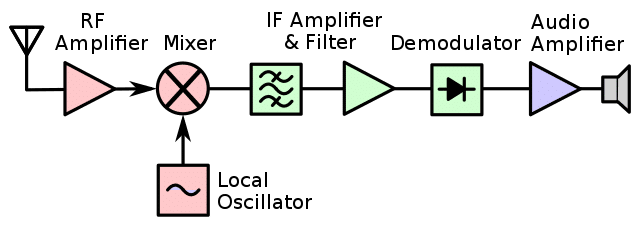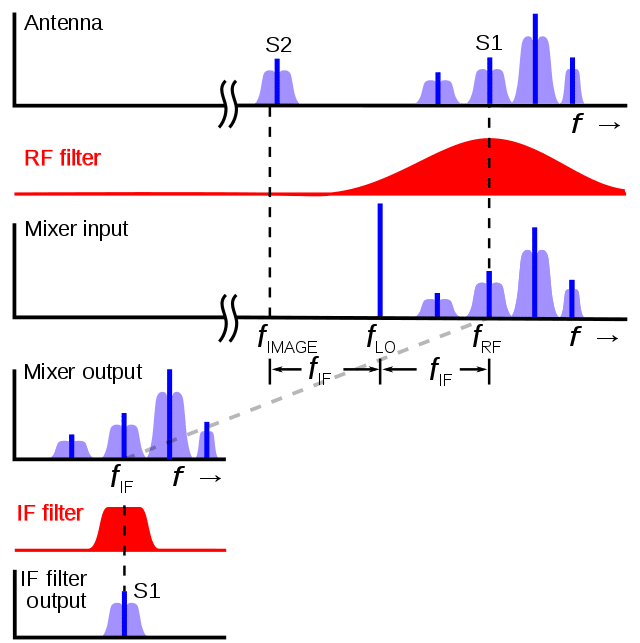



Start Here
Course Introduction: Dissecting Superheterodyne Receiver Components
This chapter provides an overview of the critical components in superheterodyne receivers by explaining the answers to 11 key questions. The course starts by exploring the mixer stage’s role in frequency conversion (Question A-006-002-001), demonstrating how it changes the incoming signal to the Intermediate Frequency (IF). Learners will understand the necessity of the Beat-Frequency Oscillator (BFO) in Single Sideband (SSB) reception (Question A-006-002-002) and delve into the functionality of the first mixer in producing the IF (Question A-006-002-003). The course also addresses practical scenarios, such as calculating the local oscillator frequency for precise signal reception (Question A-006-002-004).
Further, the course examines the offset function of the BFO relative to the incoming signal for effective SSB signal detection (Question A-006-002-005) and emphasizes the importance of oscillator stability and spectral purity in superheterodyne receivers (Question A-006-002-006). Tuning mechanisms, critical for aligning the local oscillator and ensuring accurate frequency reception, are discussed (Questions A-006-002-007 and A-006-002-008). Additionally, the process of combining signals in the mixer stage to produce the IF is explored (Question A-006-002-009), alongside an examination of which receiver stages have input circuits tuned to the same frequency for optimal mixing and selectivity (Question A-006-002-010). The chapter concludes by reiterating the primary function of the mixer stage in generating the IF (Question A-006-002-011), consolidating learners’ understanding of these fundamental concepts in radio technology.

Be sure to login to your hamshack.ca account to track your progress by clicking the [Mark Complete] Button at the bottom of each lesson. You can contact VE7DXE to sign-up for the new Basic Amateur course.
Mixer Stage Function in Superheterodyne Receivers (A-006-002-001)
Role of the Mixer Stage in Frequency Conversion
Question (A-006-002-001) focuses on the purpose of the mixer stage in a superheterodyne receiver. The correct answer, A. Change the frequency of the incoming signal to that of the IF, highlights the mixer stage’s essential function. In superheterodyne receivers, the mixer stage mixes the incoming radio frequency (RF) signal with the local oscillator (LO) frequency. This mixing process results in the creation of the intermediate frequency (IF), a lower frequency easier to filter and amplify. The IF stage can then use more selective and stable filters, improving the receiver’s overall selectivity and sensitivity.
In amateur radio, the mixer stage’s ability to convert to a stable IF is crucial for clear signal reception, particularly in environments with various signal strengths and qualities. Understanding the mixer stage’s role is essential for operators looking to modify or optimize their radio equipment for specific reception conditions.

Parallels:
- Blending Ingredients in Cooking: The mixer in a radio receiver is akin to a kitchen blender, combining two ingredients (RF and LO frequencies) to create a new product (IF).
- Creating a Musical Harmony: It’s similar to combining different musical notes to produce a harmonious chord, symbolizing the mixing of frequencies to achieve a desirable intermediate frequency.
Question Summary and Key Takeaways:
- Conversion to Intermediate Frequency: The mixer stage changes the incoming RF signal to the IF.
- Combining RF and LO Frequencies: This process involves mixing the RF signal with the LO frequency.
- Improved Receiver Performance: The conversion facilitates better filtering and amplification at the IF stage.
- Essential in Superheterodyne Receivers: The mixer stage is crucial for superheterodyne receiver functionality.
- Significance in Amateur Radio: Understanding this stage is key for amateur radio enthusiasts to achieve optimal signal reception.
Understanding the BFO in SSB Superheterodyne Receivers (A-006-002-002)
Single Side Band (SSB) communication is a form of amplitude modulation (AM) where only one of the original sidebands (either upper or lower) is transmitted, and the carrier is suppressed to reduce bandwidth and power consumption. The Beat-Frequency Oscillator (BFO) plays a pivotal role in SSB reception within superheterodyne receivers, as highlighted in answer D, by replacing the suppressed carrier for detection. This is essential for demodulating the SSB signal back into intelligible audio, as the original carrier is required to recreate the audio signal from the transmitted sideband.
The BFO generates a carrier signal at a frequency that, when mixed with the incoming SSB signal, effectively reinserts the carrier that was removed at the transmitter. This mixing process produces a signal that contains the original audio frequencies, allowing the receiver’s demodulator to recover the audio information. Without the BFO, the receiver would be unable to demodulate the SSB signal, as there would be no reference frequency to “beat” against the received sideband, making the BFO an indispensable component in SSB superheterodyne receivers.
Parallels:
- Filling in the Missing Piece of a Puzzle: Imagine you’re trying to complete a jigsaw puzzle, but one crucial piece is missing, making it impossible to see the full picture. The BFO in an SSB receiver acts like a replacement piece for that puzzle. Even though the original piece (carrier) was intentionally removed (suppressed) to save space (bandwidth) and energy, the BFO provides a new piece that fits perfectly, allowing you to see (hear) the complete picture (audio signal) once again.
- The Role of a Conductor in an Orchestra: Consider an orchestra where the conductor is suddenly absent. The musicians might still play, but the performance could lack cohesion and precision. The BFO functions similarly to a conductor stepping in for an absent one in an SSB receiver. It sets the tempo (carrier frequency) and ensures that the music (audio signal) can be performed (demodulated) as intended, despite the original conductor’s (carrier’s) absence.
Question Summary and Key Takeaways:
- The BFO is critical in SSB superheterodyne receivers for replacing the suppressed carrier, enabling the demodulation of the SSB signal into audio.
- SSB transmissions save bandwidth and power by transmitting only one sideband and suppressing the carrier, which must be reintroduced at the receiver for successful demodulation.
- The BFO generates a signal that mixes with the incoming SSB signal, providing a reference frequency that allows the original audio frequencies to be recovered.
- Analogies of completing a puzzle with a missing piece and a conductor stepping in for an orchestra illustrate the BFO’s role in filling in what’s missing for the system to function correctly.
- Understanding the function of the BFO in SSB reception is crucial for advanced amateur radio operators, enhancing their ability to work with various modulation schemes.
First Mixer in Superheterodyne Receivers (A-006-002-003)
Function of the First Mixer in Frequency Conversion
Question (A-006-002-003) explores the role of the first mixer in a superheterodyne receiver. The correct answer, B. An intermediate frequency, indicates that the first mixer’s primary function is to produce an IF by mixing the incoming signal with the LO frequency. The mixer takes the RF signal received by the antenna and combines it with a frequency generated by the local oscillator. This process results in the creation of two new frequencies: the sum and difference of the two original frequencies. The difference frequency is typically designed to be the IF, which is then further processed by the receiver.
The choice of IF is crucial in determining the receiver’s performance characteristics, including selectivity and sensitivity. For amateur radio operators, understanding the role of the first mixer is fundamental in grasping how their equipment processes and refines incoming signals for optimal clarity and reliability.
Parallels:
- Chemical Reaction in a Lab: The first mixer’s function can be likened to a chemical reaction where two substances combine to form a new compound, symbolizing the mixing of RF and LO frequencies to produce the IF.
- Creating a Blend in Art: Similar to blending colors in art to achieve a specific shade, the mixer combines frequencies to achieve the desired IF.
Question Summary and Key Takeaways:
- Production of Intermediate Frequency: The first mixer’s primary role is to produce the IF.
- Mixing RF and LO Frequencies: This is achieved by combining the incoming RF signal with the LO frequency.
- Sum and Difference Frequencies: The mixing process creates new frequencies, with the IF being the difference frequency.
- Impact on Receiver Performance: The IF selection is vital for the receiver’s selectivity and sensitivity.
- Understanding for Amateur Radio: Knowledge of the first mixer’s function is essential for amateur radio enthusiasts.
Local Oscillator Operation in Superheterodyne Receivers (A-006-002-004)
Calculating the Local Oscillator Frequency
Question (A-006-002-004) involves determining the operating frequency of the local oscillator in a superheterodyne receiver. The correct answer, C. 5,400 kHz, is obtained by subtracting the first Intermediate Frequency (IF) from the incoming signal frequency. In this scenario, with an incoming signal of 3,600 kHz and an IF of 9 MHz, the local oscillator must operate at 5,400 kHz. This calculation is based on the superheterodyne principle, where the difference between the local oscillator frequency and the incoming signal frequency should equal the IF.
This understanding is essential for amateur radio operators who may be involved in aligning or troubleshooting their receivers. Accurately setting the local oscillator frequency is crucial for ensuring that the receiver correctly processes the desired signal frequency.
Parallels:
- Setting a Clock for a Time Zone: Adjusting the local oscillator frequency is like setting a clock to align with a specific time zone, ensuring accurate time display.
- Balancing a Scale: It’s akin to adding or removing weights on a scale to balance it at a specific measurement, representing the adjustment of the local oscillator to achieve the desired IF frequency.
Question Summary and Key Takeaways:
- LO Frequency Calculation: The local oscillator frequency is determined by subtracting the IF from the incoming signal frequency.
- Superheterodyne Receiver Principle: This calculation is fundamental to the operation of superheterodyne receivers.
- Accuracy in Signal Processing: Correctly setting the LO frequency is essential for the receiver to process the desired signal accurately.
- Amateur Radio Applications: Understanding LO frequency settings is crucial for radio enthusiasts in aligning and maintaining their equipment.
- Essential for Troubleshooting: Knowledge of LO operation aids in troubleshooting and optimizing receiver performance.
Beat-Frequency Oscillator Offset (A-006-002-005)
Purpose of BFO Offset in SSB Reception
Question (A-006-002-005) asks why the Beat-Frequency Oscillator (BFO) is offset slightly from the incoming signal to the detector in an SSB receiver. The correct answer, B. To beat with the incoming signal, explains the need for the BFO to be slightly off-set to effectively detect SSB signals. This offset creates a heterodyne or “beat” frequency when the BFO signal mixes with the incoming SSB signal. This beat frequency falls within the audible range and allows the originally transmitted audio to be recovered from the SSB signal.
For amateur radio operators using SSB, understanding the role of the BFO and its offset is crucial. The offset is typically in the range of 500 to 1,500 Hz, and it is this slight difference that enables the demodulation of the SSB signal into intelligible audio.
Parallels:
- Tuning a Musical Instrument: The offset of the BFO is like fine-tuning a musical instrument to harmonize perfectly with another instrument, creating a pleasant combined sound.
- Combining Flavors in Cooking: It’s similar to adding a specific ingredient to a dish to achieve the perfect balance of flavors, symbolizing the addition of the BFO signal to the incoming SSB signal to produce audible audio.
Question Summary and Key Takeaways:
- BFO Offset for SSB: The BFO is slightly offset from the incoming SSB signal to create a beat frequency.
- Audio Signal Recovery: This process allows for the demodulation of SSB signals into audio.
- Range of Offset: Typically, the offset is between 500 to 1,500 Hz.
- Crucial for SSB Reception: Understanding this offset is essential for operators using SSB modes.
- Heterodyne Frequency Creation: The offset enables the creation of a heterodyne frequency within the audible range
Oscillator Stability in Superheterodyne Receivers (A-006-002-006)
Importance of Oscillator Stability and Purity
Question (A-006-002-006) delves into the qualities necessary for oscillators in a superheterodyne receiver. The correct answer, D. Stable and spectrally pure, emphasizes the importance of both stability and spectral purity in oscillators. Stability refers to the oscillator’s ability to maintain a constant frequency over time and under varying conditions, which is crucial for accurate frequency conversion and reception. Spectral purity, or low phase noise, ensures that the oscillator’s output is as close to a single frequency as possible, minimizing the generation of spurious signals or harmonics that can interfere with reception.
In the context of amateur radio, stable and spectrally pure oscillators contribute significantly to the overall performance of a receiver. They ensure that signals are accurately converted and processed, leading to clearer reception and less interference.
Parallels:
- Precision in Instrument Tuning: This requirement is akin to the need for precise tuning in musical instruments, where stability and purity of the note are crucial for harmonious sound.
- Accuracy in Timekeeping Devices: It’s similar to the need for precision and
consistency in timekeeping devices, where the accuracy and purity of the timing mechanism are vital for reliable performance.
Question Summary and Key Takeaways:
- Stability in Frequency Maintenance: Oscillators must maintain a constant frequency over time for accurate reception.
- Spectral Purity is Key: The spectral purity of oscillators ensures minimal generation of spurious signals.
- Impact on Receiver Performance: Stable and pure oscillators significantly enhance the performance of a superheterodyne receiver.
- Essential for Amateur Radio: Accurate oscillators are crucial for amateur radio enthusiasts for effective signal conversion and reception.
- Minimizing Interference: Spectrally pure oscillators help reduce interference, improving signal clarity.
Local Oscillator Tuning in Superheterodyne Receivers (A-006-002-007)
Tuning the Local Oscillator for Frequency Alignment
Question (A-006-002-007) examines the purpose of a variable capacitor in a superheterodyne receiver. The correct answer, C. Tuning of the local oscillator (LO), identifies the role of this component in tuning the LO. In a superheterodyne receiver, the local oscillator’s frequency is critical for determining the frequency to which the receiver is tuned. The variable capacitor, in conjunction with an inductor, forms a tunable LC circuit that allows the frequency of the LO to be adjusted. This tuning is essential for aligning the LO frequency with the desired reception frequency, ensuring that the receiver correctly processes the incoming signal.
For amateur radio operators, precise tuning of the LO is fundamental for successful communication, as it directly affects the accuracy and clarity of the received signals. Understanding how to adjust the LO is a key skill in radio operation and maintenance.
Parallels:
- Adjusting a Telescope: Tuning the LO is similar to adjusting a telescope to focus on a specific star, aligning the instrument for clear observation.
- Calibrating a Scientific Instrument: It’s akin to calibrating a scientific instrument to ensure accurate measurements, reflecting the need for precise adjustment in the receiver.
Question Summary and Key Takeaways:
- LO Frequency Adjustment: The variable capacitor is used for tuning the frequency of the local oscillator.
- Critical for Receiver Tuning: Accurate LO tuning determines the receiver’s tuned frequency.
- LC Circuit for Tunability: The capacitor forms part of a tunable LC circuit for frequency adjustment.
- Skill Required in Amateur Radio: Understanding and adjusting the LO is a vital skill for radio operators.
- Impact on Signal Reception: Proper LO tuning affects the clarity and accuracy of the received signals.
Preselector Tuning in Superheterodyne Receivers (A-006-002-008)
Function of the Preselector Tuning in Receivers
Question (A-006-002-008) addresses the purpose of a variable capacitor in a superheterodyne receiver without an RF amplifier. The correct answer, C. Tuning the receiver preselector to the reception frequency, explains the role of the preselector. The preselector is a tuned circuit that helps the receiver selectively focus on the desired signal frequency while rejecting others. The variable capacitor, in conjunction with an inductance, forms a tunable circuit that allows the operator to adjust the preselector to the frequency of the signal they wish to receive.
In amateur radio, the preselector is particularly important in receivers without an RF amplifier, as it serves as the first stage of selectivity and sensitivity. Effective tuning of the preselector is crucial for optimizing the receiver’s performance, especially in environments with multiple competing signals.
Parallels:
- Focusing a Lens in Photography: Tuning the preselector is like adjusting the focus on a camera lens, targeting a specific subject while blurring out the background.
- Selective Hearing in a Busy Environment: It’s akin to concentrating on a single conversation in a noisy room, filtering out unrelated noises to hear one particular voice clearly.
Question Summary and Key Takeaways:
- Preselector for Signal Focus: The variable capacitor is used to tune the preselector to the desired reception frequency.
- Essential in Absence of RF Amplifier: In receivers without an RF amplifier, the preselector provides initial signal selectivity.
- Tunable Circuit for Reception: The combination of a variable capacitor and inductance allows for precise frequency adjustments.
- Optimizing Receiver Performance: Effective preselector tuning is key for enhancing the receiver’s ability to isolate and amplify the desired signal.
- Crucial for Clarity in Amateur Radio: Accurate tuning of the preselector is vital for clear reception in crowded signal environments.
Mixer Stage in Frequency Conversion (A-006-002-009)
Combining Signals to Produce Intermediate Frequency
Question (A-006-002-009) asks about the receiver stage that combines a 14.25 MHz input signal with a 13.795 MHz oscillator signal to produce a 455-kHz intermediate frequency (IF). The correct answer, A. Mixer, identifies the role of the mixer stage in this process. The mixer is crucial in a superheterodyne receiver for combining the incoming RF signal with the local oscillator (LO) signal. In this case, mixing a 14.25 MHz input signal with a 13.795 MHz LO signal results in an IF of 455 kHz, which is the difference between these two frequencies.
This concept is important in amateur radio as it demonstrates how the mixer stage effectively shifts the frequency of the received signal to a more manageable IF for further processing and amplification. Understanding the function of the mixer helps amateur radio operators comprehend the signal processing happening within their receivers.
Parallels:
- Creating a New Recipe by Mixing Ingredients: The mixer stage is like combining ingredients in cooking to create a new dish, symbolizing the mixing of RF and LO signals to produce a new frequency.
- Blending Colors in Art: Similar to blending different colors to produce a new shade, the mixer combines frequencies to achieve the desired IF.
Question Summary and Key Takeaways:
- Mixer’s Role in Frequency Conversion: The mixer stage combines the incoming signal with the LO signal to produce the IF.
- Frequency Difference Production: The IF is the difference between the RF signal and the LO frequency.
- Essential in Superheterodyne Receivers: Understanding the mixer’s function is key for amateur radio enthusiasts.
- Signal Processing Simplification: The conversion to IF simplifies the signal processing in the receiver.
- Practical Application in Radio Communication: This concept is crucial for operators in tuning and modifying their radio equipment.
Tuned Circuits in Superheterodyne Receivers (A-006-002-010)
Tuning of RF and First Mixer Stages
Question (A-006-002-010) inquires which two stages in a superheterodyne receiver have input tuned circuits tuned to the same frequency. The correct answer, B. RF and first mixer, indicates that both the Radio Frequency (RF) amplifier stage and the first mixer stage are tuned to the same incoming signal frequency. This tuning is essential for the superheterodyne receiver’s operation as it ensures that the RF signal is appropriately processed and that the mixer stage can effectively convert it to the intermediate frequency.
The tuning of these stages is particularly significant in amateur radio, where precision in signal reception is crucial. Operators need to understand the importance of this tuning for optimizing their receivers’ performance, particularly in environments with various signal strengths and interference levels.
Parallels:
- Synchronized Musical Instruments: This tuning is akin to two musical instruments synchronized to play the same note, ensuring harmony in the performance.
- Coordinating a Dance Routine: Similar to dancers coordinating their movements to the same rhythm, the RF and first mixer stages must be in tune for effective signal processing.
Question Summary and Key Takeaways:
- RF and Mixer Stage Tuning: Both the RF and the first mixer stages are tuned to the same incoming signal frequency.
- Crucial for Superheterodyne Operation: Proper tuning of these stages is essential for the receiver’s functionality.
- Importance in Amateur Radio: Accurate tuning ensures effective reception and processing of signals.
- Signal Conversion Efficiency: This synchronization aids in the efficient conversion of the RF signal to the IF.
- Optimizing Receiver Performance: Understanding this tuning helps amateur radio operators in adjusting and improving their equipment.
Function of the Mixer Stage in Superheterodyne Receivers (A-006-002-011)
Primary Role of the Mixer Stage
Question (A-006-002-011) addresses the primary function of the mixer stage in a superheterodyne receiver. The correct answer, C. Produces an intermediate frequency, reiterates the crucial role of the mixer in these receivers. The mixer stage is responsible for producing the intermediate frequency (IF) by mixing the incoming RF signal with a signal from the local oscillator. This process is central to the superheterodyne principle, allowing for effective filtering and amplification at the IF stage, which is simpler and more efficient than processing at the original RF.
Understanding the mixer’s role is vital for amateur radio operators in both using and troubleshooting their receivers. It’s a key component in ensuring that the receiver can accurately process a wide range of frequencies and maintain high-quality signal reception.
Parallels:
- Alchemist Mixing Elements: The mixer stage can be likened to an alchemist mixing different elements to create a new substance, symbolizing the combination of RF and LO signals to produce the IF.
- DJ Blending Tracks: Similar to a DJ blending different music tracks to create a new sound, the mixer combines frequencies to produce the desired output.
Question Summary and Key Takeaways:
- Creation of Intermediate Frequency: The primary role of the mixer is to produce the IF.
- Mixing RF and LO Signals: This involves combining the incoming RF signal with the LO frequency.
- Central to Superheterodyne Principle: The mixer’s function is key to the operation of superheterodyne receivers.
- Simplifies Signal Processing: Conversion to IF allows for more efficient filtering and amplification.
- Essential Knowledge for Radio Operators: Understanding the mixer stage is crucial for effective use and maintenance of radio equipment.
Course Recap: Understanding Oscillators, Mixers, and Tuning in Superheterodyne Receivers
To conclude, this chapter has provided a detailed overview of essential components in superheterodyne receivers by answering 11 key questions. Participants have learned about the role of the mixer stage in converting the frequency of incoming signals to the Intermediate Frequency (IF) as covered in Question A-006-002-001. The necessity of the Beat-Frequency Oscillator (BFO) in SSB reception, explained in Question A-006-002-002, and the process of producing the IF through the first mixer (Question A-006-002-003) were also highlighted.
The course further clarified how to calculate the local oscillator frequency for accurate signal processing (Question A-006-002-004) and examined the BFO’s offset role for SSB signal detection (Question A-006-002-005). The importance of stability and spectral purity in oscillators (Question A-006-002-006), as well as the specifics of tuning the local oscillator and preselector stages (Questions A-006-002-007 and A-006-002-008), were discussed. The course also addressed the combination of signals in the mixer to produce the IF (Question A-006-002-009) and identified which stages have input circuits tuned to the same frequency (Question
A-006-002-010). Finally, the chapter wrapped up by reaffirming the primary function of the mixer stage in generating the IF (Question A-006-002-011), solidifying the learners’ comprehension of these critical elements in radio technology.
Through this exploration, participants have gained a comprehensive understanding of how oscillators, mixers, and tuning elements work together to enhance the functionality and efficiency of superheterodyne receivers, an essential knowledge base for anyone involved in amateur radio and communication technology.
© Hamshack.ca. All lesson content, diagrams, and quizzes are proprietary and protected by copyright. Access is for personal use only and requires a valid course purchase where applicable. Copying, sharing, or redistributing any material is strictly prohibited. See the Hamshack.ca Terms of Use for full details.
